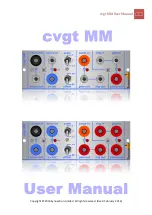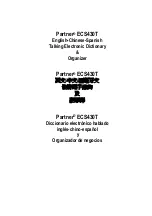
THEORY OF OPERATATION
4.3
[5] STCG (I/O and DAC)
The primary function of this logic is to show the interconnections between the GENERATOR
and other assemblies. Interconnect to the Keyboard is shown on [3]. Logic terms originating on
this assembly have their origins indicated using the term referencing system. Terms for which no
reference is shown originate elsewhere (if at all) in the instrument. Many of the signals, which
appear here, are bi-directional.
This logic also shows the Standby Battery and the Charging circuitry. The adjustment circuit for
the LCD Display contrast (R9) is also shown here.
U35, the Digital to Analog Converter is used to steer the Oscillator frequency.
4.4
[4] STCG (PROP DELAY)
When an External Reference Frequency is input, it is terminated (at about 50 Ohms) by R182,
and converted to a logic level by Schmidt trigger U49. The output of this Schmidt trigger is
applied to U 23 which selects the external input (if present) or the internal 10MHz oscillator for
division to 62.5 KHz (SELREF).
Y2 (or Y3) provides a precision 10MHz which, after conversion to logic levels by U51 is the
internal time reference for the TymMachine. When an external reference is not used, the internal
reference may be output via U50, J22 (jumper 1-2), and J5. The level may be adjusted with
R184.
U14 is a programmable counter which measures the time between the generated 1PPS and the
reference (from translator or external 1PPS) to start or steer the generator. U18 is a digitally
programmable one-shot used to implement vernier (100nS) propagation delays. U25 holds the
configuration data for the PLD, U23.
4.5
[6] STCG (GENERATOR CODE)
This logic includes derivation of the Microprocessor Clock, which is also used for timekeeping,
IRIG B output circuits, and circuits for Power-on reset.
SELREF is one input to a Phase Detector and VCO (U38). The other Phase Detector input is
VCO divided by 32 in U23. Action of the Phase Locked Loop forces the VCO to operate at
2MHz (nominal) with the stability of the selected reference oscillator. The VCO output
∅
2-IN
is used as a clock for the Microprocessor and as the reference frequency for timekeeping.
The IRIG B output circuits bandpass filter a 1KHz square wave to provide a 1KHz sine wave at
the output of U39 pin 7. The part of U39, whose output is pin 1, is operated as a follower with
gain. With FET switch Q2 ON, the gain determined by R24 and R26 is approximately 15. When
Q2 is OFF, the gain determined by R24, R27 (ratio) and R26 is approximately 5 (depending
upon adjustment of R27). Switching Q1 ON and OFF with the DC Shift form of IRIG B causes
the output at U39 pin 1 to be a 3:1 Amplitude-Modulated signal.
Symmetricom, Inc.
TM7000 TymMachine TCG/T (Rev D)
4-7
Содержание TM7000
Страница 1: ...TM7000 TymMachine Time Code Generator Translator Revision D User s Guide 8500 0101 March 2006 ...
Страница 21: ...CHAPTER ONE This Page Intentionally Left Blank 1 14 TM7000 TymMachine TCG T Rev D Symmetricom Inc ...
Страница 83: ...CHAPTER THREE This Page Intentionally Left Blank 3 56 TM7000 TymMachine TCG T Rev D Symmetricom Inc ...
Страница 99: ...CHAPTER FOUR This Page Intentionally Left Blank 4 16 TM7000 TymMachine TCG T Rev D Symmetricom Inc ...
Страница 163: ...APPENDIX A Figure One A 50 TM7000 TymMachine TCG T Rev D Symmetricom Inc ...
















































